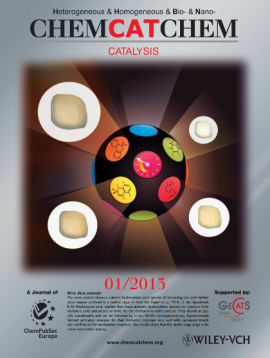
Abstract
The formation and nature of active sites for methanol conversion over solid acid catalyst materials are studied by using a unique combined spectroscopic and theoretical approach. A working catalyst for the methanol-to-olefin conversion has a hybrid organic–inorganic nature in which a cocatalytic organic species is trapped in zeolite pores. As a case study, microporous materials with the chabazite topology, namely, H-SAPO-34 and H-SSZ-13, are considered with trapped (poly)aromatic species. First-principle rate calculations on methylation reactions and in situ UV/Vis spectroscopy measurements are performed. The theoretical results show that the structure of the organic compound and zeolite composition determine the methylation rates: 1) the rate increases by 6 orders of magnitude if more methyl groups are added on benzenic species, 2) transition state selectivity occurs for organic species with more than one aromatic core and bearing more than three methyl groups, 3) methylation rates for H-SSZ-13 are approximately 3 orders of magnitude higher than on H-SAPO-34 owing to its higher acidity. The formation of (poly)aromatic cationic compounds can be followed by using in situ UV/Vis spectroscopy because these species yield characteristic absorption bands in the visible region of the spectrum. We have monitored the growth of characteristic peaks and derived activation energies of formation for various sets of (poly)aromatic compounds trapped in the zeolite host. The formation–activation barriers deduced by using UV/Vis microspectroscopy correlate well with the activation energies for the methylation of the benzenic species and the lower methylated naphthalenic species. This study shows that a fundamental insight at the molecular level can be obtained by using a combined in situ spectroscopic and theoretical approach for a complex catalyst of industrial relevance.
